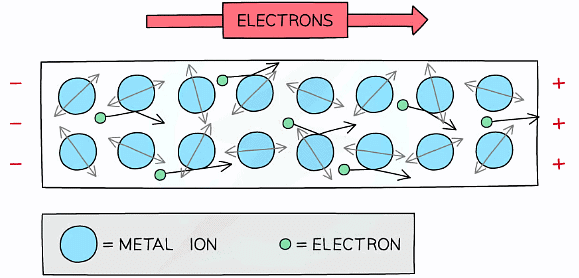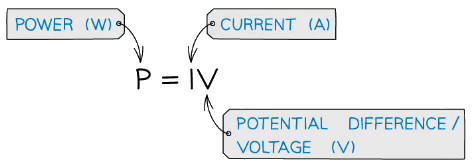Grade 10 Exam > Grade 10 Notes > Physics for Grade 10 > Heating Effects of Electric Current
Heating Effects of Electric Current | Physics for Grade 10 PDF Download
Introduction
- When electricity passes through a component, such as a resistor, some of the electrical energy is turned into heat, therefore, increasing its temperature
- The heat that is produced will dissipate (spread out) into the environment via thermal conduction, convection and radiation
- When electricity passes through a component, there is energy transferred to heat
- This is due to collisions between:
- Electrons flowing in the conductor, and
- The lattice of atoms within the metal conductor
- Electricity, in metals, is caused by a flow of electrons
- This is called the current
- Metals are made up of a lattice of ions
- As the electrons pass through the metal lattice they collide with ions
- The ions resist the flow of the electrons
 As electrons flow through the metal, they collide with ions, making them vibrate more
As electrons flow through the metal, they collide with ions, making them vibrate more
- The ions resist the flow of the electrons
- When the electrons collide, they lose some energy by giving it to the ions, which start to vibrate more
- As a result of this, the metal heats up
- This is used to an advantage to generate heat for appliances such as electric hobs
 The heating effect of current can be used for many applications such as electric hobs
The heating effect of current can be used for many applications such as electric hobs
Power Dissipation
- When an electrical current does work against electrical resistance:
- Electrical energy is dissipated as thermal energy in the surroundings
- The heat that is produced will dissipate via thermal conduction, convection and radiation
- The amount of heat produced depends on two factors:
- Current: The greater the current, the more heat that is produced
- Resistance: The higher the resistance, the more heat that is produced (for a given current)
- Note that reducing the resistance can cause the current to increase
- This could actually increase the amount of heat produced
- In mechanics, power P is defined as the rate of doing work
- The potential difference is the work done per unit charge
- Current is the rate of flow of charge
- Therefore, the electrical power is defined as the rate of change of work done:

- The work done is the energy transferred so the power is the energy transferred per second in an electrical component
- The power dissipated (produced) by an electrical device can also be written as

- Using Ohm's Law V = IR to rearrange for either V or I and substituting into the power equation, means power can be written in terms of resistance R

- This means for a given resistor if the current or voltage doubles the power will be four times as great.
- Which equation to use will depend on whether the value of current or voltage has been given in the question
- Rearranging the energy and power equation, the energy can be written as:
E = VIt - Where:
- E = energy transferred (J)
- V = voltage (V)
- I = current (A)
- t = time (s)
Which statement most accurately describes what happens?Question for Heating Effects of Electric CurrentTry yourself:Two lamps are connected in series to a 150 V power supply.
 View Solution
View Solution
The document Heating Effects of Electric Current | Physics for Grade 10 is a part of the Grade 10 Course Physics for Grade 10.
All you need of Grade 10 at this link: Grade 10
|
124 videos|149 docs|37 tests
|

|
Explore Courses for Grade 10 exam
|

|
Signup for Free!
Signup to see your scores go up within 7 days! Learn & Practice with 1000+ FREE Notes, Videos & Tests.
Related Searches






















